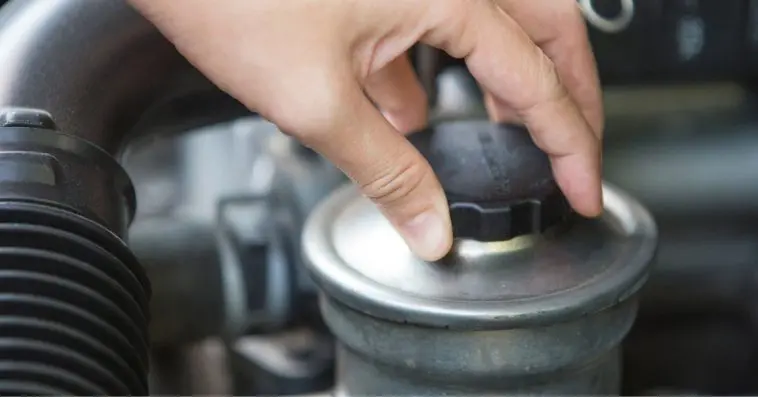Most vehicles use hydraulic power steering to bring the mechanical connection between the actual wheels and the steering.
To reduce the wear and tear of the whole system, the power steering system needs the assistance of the power steering fluid, which is used as a lubricant.
If the lubricant decreases, the outcomes may be unfavorable, so you are always advised to monitor your fluid levels and make flushes at the recommended time.
It is also important for you to know how to check power steering fluid of your vehicle.
You can check your power steering fluid levels by means of:
- First, warm the fluid by turning the steering wheel from lock to lock a number of times while having the engine in idle speed mode.
- Open the bonnet and locate the power steering tank.
- Safely remove the cap covering the steering tank.
- Check the fluid level by the use of a dipstick.
- Add the power steering fluid when it is low in the tank.
- Replace the cap and ensure that it is well fit to the tank.
Therefore, you can always check the power steering level on your own without an expert’s need.
All that is needed is a series of steps, and you would be able to determine whether you would have to refill the fluid tank.
TABLE OF CONTENTS
How Do You Know If Your Power Steering Fluid Is Low?
Modern cars are fitted with a power steering that works with the help of hydraulic pressure produced to move the vehicle.
Research indicates that when the power steering fluid is low, the wheel’s operation requires a lot of energy even though the steering wheel will turn.
If the amount of steering fluid is small, it leads to the malfunctioning of the steering wheel, which is dangerous because an accident may occur if your car is in motion.
If you see these symptoms stated below, then take prompt action to decrease the chances of being involved in an accident.
- It becomes difficult for you to turn the wheel.
- Vehicle wheels produce a whining sound when you make a turn.
- Vigorous vibration of the steering wheel even when the engine is turned off.
- Leakage of the power fluid.
- Locking of the steering wheel.
Is It Bad To Drive With Low Power Steering Fluid?
Low power steering fluid in the tank means that your steering wheel is going bad.
This puts your vehicle at a point where the integral hydraulic system will be damaged, leading to increased expenses resulting from the metal to metal lubrication act.
In some cases, you can drive for a short distance to find a place where you can refill the lubricant.
Low fluid means that your steering rack will malfunction, making steering difficult, which may lead to accidents or damage the entire hydraulic system due to increased heat, such as the pump.
When Is The Best Time To Check Your Power Steering Fluid?
Let’s say; occasionally, when you visit your mechanic, he usually checks the level of the lubricant when changing the oil. You can also do it personally when you get some minor engine failure.
The checking process takes at most 5 minutes, and you should do it when your engine is off.
Thanks to technology, because some cars have indicators that show the fluid level, whether the engine is hot or cold.
Do You Check Your Power Steering Fluid While The Car Is Running?
Depending on the car type, some cars need you to turn on the engine and let it run for a while with or without putting the steering wheel into functioning.
After the driver has cooled, you can now take an accurate reading with ease.
Some car versions have calibrations on the dipstick or on the clear cylinder for both the hot level after the engine has functioned for a while and a cold level after the engine has been off function for a period.
6 Steps To Checking Your Power Steering Fluid
The steering system is made of rack and pinion connected to the front wheels to facilitate movement.
The piston found in the rack and pinion is moved by hydraulic pressure from the power steering pump.
As discussed above, low fluid levels may lead to severe accidents or damage to the pump and other crucial hydraulic system parts.
Therefore, you are advised to check the levels of this fluid regularly!
1. Find The Reservoir Cylinder
Assuming your vehicle produces a whining sound when making turns or uses a lot of energy in turning the steering, the chances are that the power steering fluid in the cylinder is decreasing.
The barrel is clearly labeled, and its mainly made from a plastic material.
If you are having a hard time finding the bottle, feel free to refer to the manual or seek help from someone who knows since almost all models have the cylinder located in the same position.
2. Identify The Level Of The Fluid
Some cars have clear cylinders with gradations, which saves you time since you can quickly check the fluid level by just looking at the container.
If the plastic is not translucent enough, feel free to use a dipstick attached to the cap.
As explained before, in some models, you do precise readings after running the engine for a while, then letting the engine cool while some make you able to take the texts even though the car engine has been operational.
3. Check Out What Level Of The Dipstick Is Covered With The Steering Fluid
If your container is not visible enough, you will be forced to use a dipstick to check your fluid level.
Therefore you should first wipe the excess fluid on the stick by using cloth as soon as you remove it from the cylinder and then reinsert it as deep as possible and then pull it out to do your readings accurately.
4. Identify The Power Steering Fluid Color
A suitable fluid should have these three colors; it should either be clear, faint pink or amber.
A black or dark brown color indicates that the liquid is contaminated with impurities from rubber found in the connecting hose pipes, seals found in the engine, or the O-rings.
You are advised to visit your mechanic to examine the whole power steering system and advise if some parts need maintenance or replacement along with the fluid.
If the power steering fluid is darker than average, take a look at the color of the stain on the cloth or tissue you used to wipe off the fluid if you are suspicious.
If the color on the stain resembles the steering fluid, then have no doubts with your fluid as it is not contaminated.
5. In Case The Fluid Level Is Low, Refill The Cylinder To The Required Standard
Let’s assume that your car cylinder is clear with gradations on the cylinder wall.
It is advisable that you continuously add the fluid until the correct level is reached, depending on whether your model is a cold or hot fill level.
If you use a dipstick, then ensure that you don’t overfill the cylinder. Take into consideration that you should only use a steering fluid that is recommended for your vehicle.
The correct fluid has the required thickness designed for your vehicle’s power steering system.
To some extent, a person may explain to you the importance of using transmission fluid instead of the powering steering fluid finding yourself being tempted to use this option.
Experts do not recommend this as the right choice because there are a variety of fluids, and if you use a wrong fluid, the steering and its seals may jam.
Another crucial point I almost forgot is that. It’s better to underfill your fluid tank than overfilling it.
As the fluid expands due to the heat produced by the friction caused by the movement of different engine parts, it may work its magic and cause problems that will require you to replace expensive components that will be damaged.
6. Carefully Replace The Cap
Different cars have different models. To close the cylinder, in some models, all you need to do is push or screw the cap to wholly and correctly close the barrel.
Remember, this is a hydraulic pressure system and the expansive nature of the adhesive.
So, when you close the cylinder, ensure that it is firmly attached before you bang your bonnet so hard.
If you ignore refilling the tank, trust me in the end; you will incur some expenses or miss all those comfortable drives in your expensive machine. You don’t want that.
I found this video, follow him what he does:
What Level Should Your Power Steering Fluid Be At?
We all like it when our vehicles are in the right working conditions because the good conditions allow the machines to serve us efficiently.
To keep the car’s power steering system efficient, you should know what fluid level is best for our vehicles.
Let’s assume that your dipstick or fluid level is between the MAX and MIN marks, and there is no need for you to add the steering fluid.
But if the reading is below MIN, it’s advisable that you make a refill. You should add the fluid in small amounts until the desired level is reached. Make sure you add the fluid to the required limit only.
How Do You Also Check Power Steering Pump Pressure?
All you need to have in order to accomplish this task is a power steering pressure tester.
This device will help you in testing high-pressure lines, system fluid checking, control valves, power steering pump, and the pressure release valve.
Ensure that there are no external leaks before you start the test. Be careful and attentive while carrying out this practice because you are required to listen to any unfamiliar voices.
Below are guidelines on how you will go about with the test:
- Stop your engine and install the pressure gauge while putting the shutoff valve in an open position and then place a thermometer in the reservoir tank.
- Turn on the idle engine while holding the valve in position and start turning your steering wheel to the left and right directions continuously until air bubbles are released and activate the fluid into the operating temperature necessary for the test.
- Connect your gauge, close the shutoff valve for around five seconds, and compare it with the manufacturer’s specifications.
Here is a precaution that you should observe; you should not hold the valve closed for more than five seconds. You should only keep it more than five seconds if the manufacturer of the pump directs it.
Closing the valve for long will make the fluid overheat, causing severe damage to the power steering pump and other hydraulic system parts.
After doing your readings and finding out that they are not within the expected specifications, you should replace your steering pump because it is weak, or else your system will have complications. - Check the gear housing for any possible leaks while maintaining the shutoff valve open. You hold the steering against its stop and check the fluid pressure compared with the given specifications.
You should not keep the wheel in this position for a long time. Make sure the system pressure is above 1000 lbs. in every square inch.
If the pressure recorded is low, there is a possible leak in the interior gear housing, which could not be detected when carrying out a visual inspection. - Ensure readings of 1000 RPM and 3000 RPM are recorded when you check the flow control valve operation while the shutoff valve is held in an open position.
Make a comparison of the readings against manufacturer specifications. If the two readings are not within the required specifications, it means that the flow control valve is damaged and should be replaced with immediate effect.
You can also watch this video to learn from:
Conclusion
The power steering fluid located in the reservoir cylinder of your vehicle plays a vital role in determining the car’s performance.
If it is at a minimum level or contaminated, you would have a difficult time driving it because of the engine’s inability to perform at its optimum capacity.
The steering may lock, which may cause serious accidents that may cause you injuries, destroy property, or even cause deaths.
That is why you would have to make sure that the power steering fluid is always on its recommended level to avoid inconveniences.
Sources:
1. Supercheap Auto Australia – https://www.supercheapauto.com.au/blog/how-to/oils-and-lubricants/checking-and-adjusting-power-steering-fluid.html
2. wikiHow – https://www.wikihow.com/Check-and-Add-Power-Steering-Fluid




